Japan's Official Development Assistance White Paper 2011
Section 2 Japanese Economic Recovery through Aid to Developing Countries
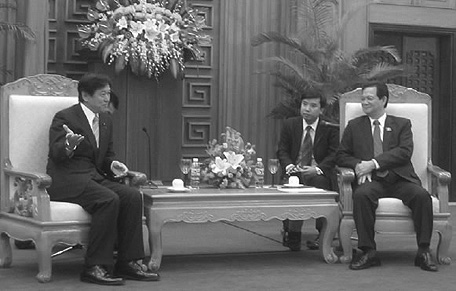
Parliamentary Senior Vice-Minister for Foreign Affairs Tsuyoshi Yamaguchi meets with Prime Minister Nguyen Tan Dung in Vietnam
To rebound and recover from the Great East Japan Earthquake as soon as possible, it is extremely important that Japan's public and private sectors unite in "open reconstruction," while cooperating with the international community as well, as also has been indicated in the "Basic Guidelines for Reconstruction." In addition to the top priority of contributing directly to recovery and disaster prevention measures in the affected areas, the 2011 Priority Policies in International Cooperation (announced June 2011) stipulate the utilization of assistance to developing countries to contribute to strong economic growth that will support Japan's recovery and reconstruction.
For example, when using ODA to assist in the overseas deployment of infrastructure by Japan's private businesses, Japan will proactively utilize its infrastructure technology, which is strong against disasters, in the ODA projects. Specifically, the improvement of a business environment (airports, ports, roads, networks), etc., that is a prerequisite for setting up overseas operations by Japanese private businesses, is mainly handled through yen loans, but grant aid is also used for preparation and maintenance of the peripheral infrastructure and for infrastructure aid as models. At such times, Japan will actively utilize technical cooperation to support the reshaping of legal systems and to promote the improvement of the environment through development of human resources, so that the excellence of Japan's quake resistance and other standards and systems will be recognized, and those standards and systems will be accepted in developing countries as well.
In addition, taking into consideration an increased emphasis on renewable energy and energy conservation in energy policy immediately after the earthquake, Japan will promote its advanced energy conservation and environmental technologies through ODA. This is part of Japan's contribution to the promotion of measures to combat climate change and to achieve green growth. Overseas deployment of such technologies is also a significant business opportunity for the private sector as well.
Moreover, in addition to promoting improvement of the environment for the activities of Japanese companies in developing countries that will support Japan's recovery and reconstruction, Japan assists the enhancement of ASEAN connectivity (Note 5), where many Japanese companies operate ( Note 6). Revitalization of trade, investment, and other private sector activities is vital to the sustained economic growth of developing countries. In addition to improvement of the infrastructure in developing countries in both the equipment and facilities aspect and the knowledge and expertise aspect, Japan will engage in support for streamlining of the systems related to trade and investment and the development of human resources, and improvement of governmental organization systems and capacity related to intellectual property protection, competition policy, etc., measures to combat degradation of the urban environment and infectious diseases, etc., thereby providing assistance in overcoming the obstacles to growth.
Finally, foreseeing an increase in demand for natural resources and energy required for recovery in the future, Japan will actively use ODA to promote the securing of a safe supply of natural resources, energy, and food, and the diversification of supply sources, while taking into consideration the basic policy for providing aid to the relevant countries. In other words, in addition to striving for stable development of countries exporting natural resources and food and the surrounding regions, Japan will build comprehensive and strategic relationships with those countries. In addition, Japan will provide assistance for the stable development and strengthening of abilities of coastal countries in order to ensure the security of Japan's sea lanes. Further, while giving appropriate consideration to the environment, Japan will promote cooperation with developing countries for the supply of energy.
Under this policy, starting from FY2011, Japan is conducting research for the formulation of aid packages, and conducting activities such as implementing measures to support the improvement of the trade and investment environment and legal systems and encouraging the spread of energy conservation and environmental technologies.
In the investigation for the formulation of aid packages, Japan formulates aid packages to strengthen the function for comprehensive and strategic implementation of activities, from plan formulation to implementation, related to the overseas deployment of Japan's infrastructure technologies (water and sewer systems, electric power, motorways, railways, information and telecommunications, etc.), and verifies test activities in some cases.
Further, in Japan's assistance for improvement of the trade and investment environment and the legal system, Japan provides assistance for the reform of civil law, improvement of transparency in investment laws and the resolution of civil disputes, improvement of the level of customs clearance procedures, and enactment of intellectual property rights protection legislation, etc., to make it possible to establish a system that enables smooth operation of corporate activities and to provide a business environment that is favorable to private businesses in developing countries in Asia and other regions.
To encourage the spread of energy conservation and environmental technology, Japan assists in the formulation of policy, the building of systems of implementation, and the development of human resources to enable the formulation of energy conservation strategy and basic plans, as well as the implementation and promotion of the spread of energy conservation, in the public sector and the industrial sector, etc.
Through these efforts, Japan will provide aid to developing countries in the future as well, while contributing the Japan’s economic recovery at the same time.
Notes:
(5) Enhancing connectivity in ASEAN refers to three things: "Physical connectivity," such as transportation, telecommunications, and energy networks, "Institutional connectivity," such as trade, investment, and liberalization/facilitation of services, and "People-to-people connectivity," such as tourism, education, and culture. (See the diagram on the next page.)
(6) It is necessary to consider a mechanism to mobilize aid funding from the private sector utilizing the Japan Bank for International Cooperation (JBIC), etc., in addition to ODA.
Master Plan on ASEAN Connectivity
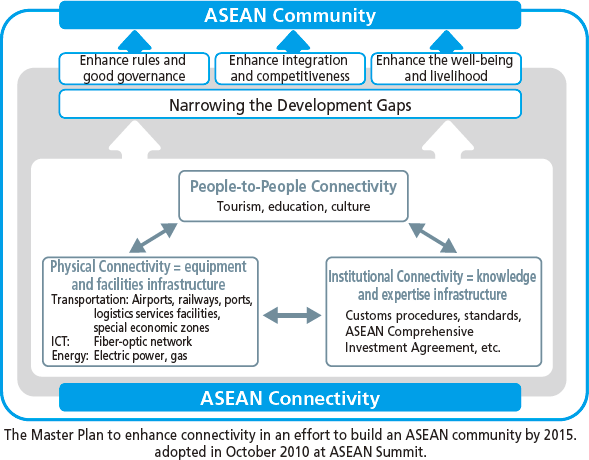
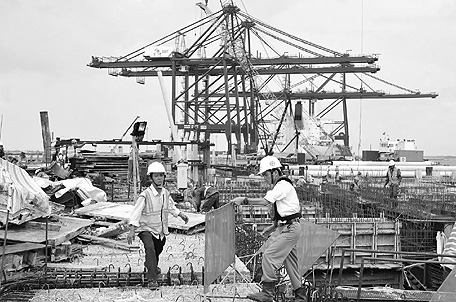
The Cai Mep Port construction site that is part of "the Cai Mep-Thi Vai International Port Construction Project" in Vietnam (Photo: Koji Sato/JICA)
Overall image of Japan's support for ASEAN Connectivity (equipment and facilities infrastructure)
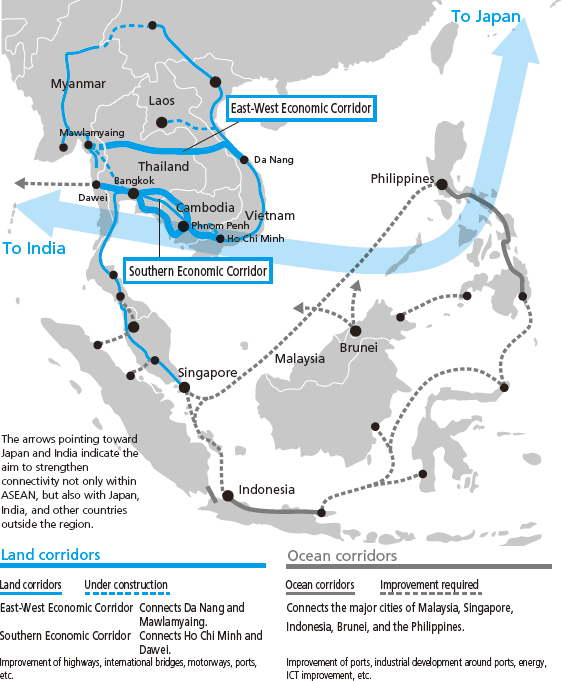

The site of "Sihanoukville Port Special Economic Zone Development Project" to construct Cambodia’s only deep-water port facing the open sea
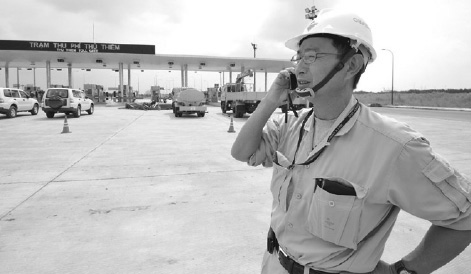
At a tollbooth for the Saigon River Tunnel that is part of the "Saigon East-West Highway Construction Project" in Vietnam (Ho Chi Minh City) (Photo: Koji Sato/JICA)
Terminology
*Economic Corridor
Refers to the group of projects that include not only the aspects of the equipment and facilities infrastructure such as development of roads, bridges, but also the aspects of the knowledge and expertise infrastructure such as simplification of customs clearance procedures, and that are intended to extend the benefits of development to the growth of industry along the corridor and the improvement of the lives of the people. The aim is to revitalize the economy through the overall improvement of the distribution infrastructure in this manner to increase the amount of transportation between regions. Specific examples include the East-West Economic Corridor that connects the regions of the Mekong, from Myanmar through Thailand, then to Laos and Vietnam, and the Southern Economic Corridor, that extends from Bangkok, Thailand through Cambodia, and to Ho Chi Minh, Vietnam.
